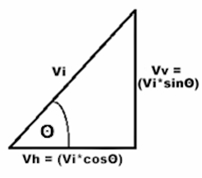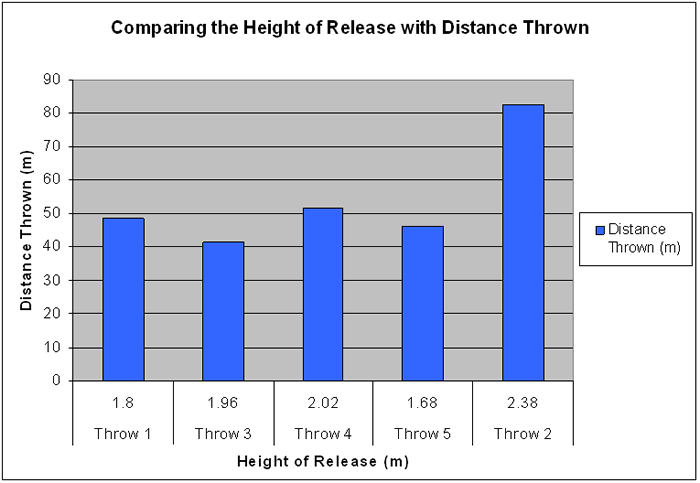|
Q4E Case Study 15 – Projectile Motion Proposed Subject usage: Introduction
In order to analyse projectile motion, it is divided into two components, horizontal motion and vertical motion. Perpendicular components of motion are independent of each other i.e. the horizontal and vertical motions of a projectile are independent. Horizontal motion of an object has no external forces acting upon it (with the exception of air resistance but this is generally not accounted for). Due to this absence of horizontal forces, a projectile remains in motion with a constant horizontal velocity, covering equal distances over equal periods in time. Thus no horizontal acceleration is occurring. The degree of vertical velocity however, is reduced by the effect of gravity. Force of gravity acts on the initial vertical velocity of the javelin, reducing the velocity until it equals zero. A vertical velocity of zero represents the apex of the trajectory, meaning that the projectile has reached its max height. During the downward flight of the projectile, vertical velocity increases due to the effect of gravity.
The initial velocity (Vi) of a projectile, released at an angle to the horizontal, has both horizontal (Vh) and vertical (Vv) components. When calculating the horizontal motion, acceleration is taken as 0ms‾² as there are no forces acting in the horizontal direction. Thus, as there is no acceleration, this means that the initial horizontal velocity and the final horizontal velocity are the same. Acceleration in the vertical motion is 9.81 ms‾² as gravity is the only force in the vertical direction. This value is constant regardless of the weight, size etc. of the object being projected. If an object is released and lands at the same height, then the initial velocity and the final velocity will be the same with the only difference being that the final velocity is in the opposite direction. The peak height reached by an object can be found by assuming the peak height to be the final velocity, which is 0ms‾¹, as when the object reaches its peak height vertical velocity is 0ms‾¹. If an object is dropped from a height the initial velocity (u) is 0ms‾¹ and from this the final velocity can be calculated.
Objectives
Methods The videos have been calibrated and digitised using the Quintic software. Functions of the Quintic Software used:
Results Each of the javelin throws were analysed using single point digitisation. Every frame from the point of release until the end of the video was digitised. Using the results given from the digitisation, values such as distance of the throw, time of the throw and max height reached by the javelin were calculated.
Table 1: Results from the five Javelin Throws
Graph 1: Initial Velocity of Javelin Throws Graph 1 shows the initial velocities of all the throws. The initial velocity of a javelin throw determines the height and length of the trajectory, providing all other factors are held constant. Throw 2 had the highest initial velocity average of 28.13ms‾¹ with the rest having slightly lower averages of 21.48ms‾¹, 19.70ms‾¹, 22.11ms‾¹ and 20.87ms‾¹ for throws 1-5 respectively. Knowing the initial velocity value, the horizontal and vertical values can be derived. Horizontal velocity of the javelin remains constant throughout the flight time, because of there being no external forces acting on the horizontal motion. Vertical velocity on the other hand is constantly changing because of the force of gravity. Table 1 shows that for all the throws, the final vertical velocity is greater than the initial velocity, and is a negative value. This is due to the javelin being released from a height. If an object is projected and lands at exactly the same height, then the initial velocity and the final velocity are the same. However, if an object is projected from a height and it lands below this height then the final velocity will be greater than the initial velocity and in the opposite direction. All the throws experience a negative final velocity as all of the javelins were released from a height. Throw 2 has a greater final vertical velocity than the rest, -19.55ms‾¹. This is because it travelled a further distance and reached a higher height, therefore the force of gravity was acting of the javelin for a longer period of time before if hit the ground.The three main variables that affect the javelin throw are initial velocity, angle of release and height of release of the javelin. One of these variables alone is not enough to ensure a good throw. From the calculations in table 1, throw 2 is deemed the most successful throw as it travelled the longest distance of 82.37m. A trend can be seen in this throw in comparison to the others. Throw 2 has the smallest angle of release (40.65º), the highest initial velocity (28.13m‾¹), and is released from the highest height (2.38m). All of these combined results in the longest distance being thrown.
Graph 2: Angle of Release and Distance Thrown The shape of the projectile trajectory is determined by the projection angle. The optimum angle of release, for a projectile being released at ground level, is 45º. If the relative height of projection increases, the angle of release should decrease. Conversely, if the relative height of projection decreases, the angle of release should increase. The optimum release angle of the javelin throw is between 34-36º. However, this angle does not take into account external factors such as wind and therefore must be altered in accordance to minimise or maximise its effect. If there is a wind blowing against the flight of the javelin, then angle of release should be slightly decreased, whereas if throwing into a tailwind, the angle of release should be greater.
Figure 2: Angle of Release of the Javelin throws Graph 2 and figure 1 show the angles of release of the five javelin throws in ascending order compared with the distance thrown. The throw with the lowest angle (throw 2, 40.65º) has by far reached the longest distance (82.37m). The rest of the throws do not follow the same pattern with the largest angle of release having the second longest distance. This is because angle of release is only one of the factors that affect the distance thrown, and while the angle of release might not be near the optimum, other factors may be more precise thus giving a good result. Enhancing the angle of release may result in a longer distance being reached Graph 3 and figure 2 show the different heights at which the javelins were released. Throw 2, who had the longest distance, 82.37m, had the highest release point of 2.38m. The rest of the throws threw at heights of 1.80m, 1.96m, 2.02m and 1.68m respectively.
Graph 3: Height Released and Distance Thrown The height at which the javelin is released affects the optimum angle of release. The greater the height, the lower the angle should be in order to increase the distance thrown. The height of release can mainly be determined by the natural stature of the athlete, and may bear taller athletes with a slight advantage over their competitors. Therefore, javelin throwers often have to determine their own optimum angle of release to suit their height. Generally, when the projectile velocity and the angle of projection are held constant, the higher the projection height, the longer the flight time. Hence, if flight time is longer then distance is greater.
Figure 3: Height Released from Ground
Graph 4: Angle of Release of Javelin Graph 4 compares the height of release with the angle of release. It would be expected that as the height increases, the angle decreases. The optimum angle of release from ground level is 45º; thus, all the throws should be released at an angle less than 45º. Only three of the throwers have an angle of release less than 45º, throw 2 which released the javelin 2.38m above the ground at an angle of 40.65º, throw 4 which release the javelin at 2.02m above the ground at an angle of 43.41º and throw 5 which released the javelin 1.68m above the ground at an angle of 43.63º. The other two throws had angles just above 45º of 45.55º and 45.58º for throws 1 and 3 respectively. Decreasing their angle of release may increase the distance of their javelin throw. Conclusion: The distance of a projectile can also be calculated, by using the initial velocity, angle of release and height of release, from the following equation:
|
Projectile Motion Sports Science Degree Physical Education | Quintic Sports









